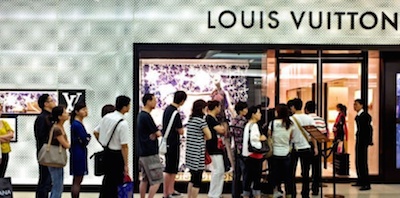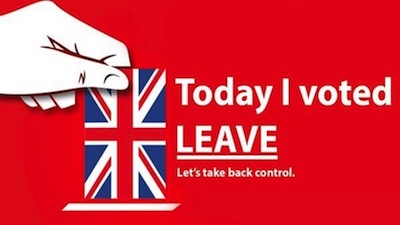The difference between the most optimistic and most pessimistic scenarios for retail through 2030 is $5.5 trillion, according to A.T. Kearney.
Depending on the impact of the Trans-Pacific Partnership (TPP), China’s economic performance, growth in emerging markets and myriad geopolitical factors, revenue could reach $17.8 trillion. Many factors are out of brands’ control, meaning agility and foresight on geographic and political scales are the key attributes of the future.
“Emerging Market Retailing in 2030” summarizes patterns of growth in recent years and examines four separate scenarios for future growth spanning technological and geopolitical/economic factors.
"Emerging Markets have been the main engine of growth for luxury in the past decade especially China, Russia, Middle East and Brazil," said Hana Ben-Shabat, partner in the retail practice of A.T. Kearney and co-author of this study.
"Going forward there will be growth coming from places like Indonesia, and India where the growth in high net worth individuals has been vibrant, along with the growth of the middle class," she said. "Accessible luxury as a category is more applicable with the growing middle class."
Four scenarios
The three forces that will exert the largest influence on the business world in 2030 are rising geopolitical instability, persistent economic uncertainty and accelerating technical adoption.
Today, these traits are already seen in Middle Eastern conflicts, Russia’s relations with the West, lifting of sanctions against Iran, tensions on the South China Sea, Brazil’s implosion, oil prices and its related impacts and the way ecommerce has enabled entry into emerging markets.

Canali Beijing store
A.T. Kearney devised four disparate scenarios that could result from the interplay of these factors. In one, cross-border integration and the adoption of technology create a best-case scenario for retailers.
In this “Seamless Dreams” scenario, the TPP will be implemented in 2018 and see more nations join in 2023, while African infrastructure investments begin showing results in 2022.
However, the looming threat of recession and protectionism, along with insufficient development of technological infrastructure, could force international retailers to focus domestically once again in a “Back to the Past” scenario. If China’s slowdown and continues and India follows and NAFTA sees push back as well, FDI flows will decelerate and hinder technology.
In this model, however, swelling income inequality allows luxury brands to prosper by targeting the ultra wealthy even as “accessible luxury” becomes unaffordable to the middle class of emerging markets.

Chinese consumers at a Louis Vuitton boutique
In one model between the two extremes, China reforms its hukou, or housing system, and resumes fast growth, but cyber-attacks become common enough to stifle ecommerce growth. In this model governments embrace free trade but consumers remain skeptical, thereby limiting retail to competitive urban centers, resulting in a 3.9 percent CAGR compared to a 3.4 percent baseline.
Luxury will thrive in this model, as the relative revitalization of in-store plays to their strengths, and the historical concentration of wealth in urban areas means luxury is inoculated from a rural demise.

The UK's withdrawal from the European Union signals the growth of protectionist sentiment
Lastly, a failure to embrace open trade might mean that only countries with pre-existing tech resources offer expansion opportunities. Continued instances of nationalist populism would eventually suffocate resource development in emerging markets, resulting in a growth rate only slightly higher than the worst-case scenario.
Long-term analysis
The growth regions are discrete across the four scenarios, meaning that brands will need to base their investments on complex market analyses and be ready to pivot quickly if necessary. As certainty of one model or another increases, brands need to be able to quickly adapt their strategies and beat competition to the largest growth segments, whether they are established or domestic markets.
Already, political events unthinkable mere months ago are carrying economic repercussions that brands will have to navigate.
Last week, the United Kingdom voted to leave the European Union, a decision that is already having an impact on the global markets.
A referendum held on June 23 passed with 52 percent of British voters choosing to leave the E.U., the news of which caused a $2 trillion hit to global stocks, the pound to fall 10 percent to the dollar and the euro to drop 3 percent. Britain’s secession from the political-economic union will be a two-year process, but the impact of this time of uncertainty has been immediate (see story).
When looking for emerging markets replete with growth potential, a previous A.T. Kearney report notes that alongside China and India, Malaysia, Kazakhstan and Indonesia are the most promising.
China and India are predictably the two most markets with the most potential, thanks in large part to their enormous populations, but the APAC region in general is full of promise. With retail sales in developing markets now constituting more than half of global revenue, brands must be precise in determining which developing markets offer the greatest opportunity (see story).
"[if income inequality continues to rise] it will [suffocate emerging markets], in which case the focus will be more on the top layer of the population in terms of wealth," Ms. Ben-Shabat said. "But that alone will not be sufficient to replicate the historical double digit growth we have seen in places like China and Russia, before those two countries started to slow down."
{"ct":"ZeE8ysfz8YaRNnigzoULZllP2mTUYrAQXEFR3S7pAe51VAqwq9TiJxGCDGdha78PEW7g5K3iVcARsQWOLcjWlTO1FceqqiiEERaNkEJwOybKOBqT0imJtRCAxIuh49ksR0iucYm\/ciV5BKqHWmImXyVloDvBFH0OqgsPtps9d+K57+HNb3ivMa5sta06qwbcSrf3yII7YOzL948KukSbwUIxGRtj7jQOHy3feqH7xNqIUyQ3+GiG\/SLLXmmTC3QP+DOD0bWdi2y4IKtxoWWTWI+v37VRHIQk4w5xcNvOL\/qdVpWmuz8qh4wulNCJpNVTj56DQVLilWJIsJOWJXBq5+\/BLjpyab\/YN8GvenZs8a+o8EP646OZMuAWgDx5lAvnHGIB2n085CkXfd1puPunYgFEcWaOpAuB3JUCZNjB0+hSgjan4rzVpfb0Rv25ajlZJGWt7aUg9OZZAUVg4nXtCnqdC5I9YOymN7CpXdCD4+c3P9RrVbFcEuLozJ67NGwhHC9UL+MFbxOnbrkvwduRC\/YLKjtkbzo9jl52KeuXqBO6giuGSvtegRJgMIFwPTjmGQiwAEQ8ME8CF7cSlTQpFPPba9O3f9w3wQbma0WoyBynWLXUNiuO5fciILjQFfUK1Nc5IOgoQSecmdXs6SU8Jq9R3\/QvtYVFVeToBPHYcoG5j+AN3FTH4VeY4f6UNRQgG7lrtCOb\/Mkma+hA65d+Z95EHUEkFvfbqKXu4hlcLqjn5YpaAOT63hDEtd6VT9fqOBN1hnx8qCAOxxqFcwojt7OaE2ShivZr+g9EEtqT5+8FMvQfULZOjUp4WvzkmgimVI71WOkDOQ72xPZG+s3qjgOgvFlQBizfzK4Xz6p140YbQ0TfSMYr10JYLM2PLq7gC5oxTLz01z5jwtNo5r89dFQhsNfpab1w0+ZLeNLhDXpIeSDonL5zhutuli5J9SGVe\/u3uUSbUgTqZboLkUDMSIi3viTz7JmQYI15KiR+DzNLn1LNyoYARegmUVgdfEyH2VeW9zlSBBIKMAiMenSFcZ5NcTOlP3HXpXOZtMWOK8MiF9T+5cIOx1ewMtG9qiC4cv7OzKOb3t\/U6wcaA6dYOVpL1s2oEEwdFyTubrvnBEez1tHAEEph1vPE7IT35yeoKL6JnqUKQJofDHrkB6KSi8b8X2LqAhTI06lIRUAdgLC4pl6f7QGETWMEQQsgGw068+CMk0JE7rS2WPHkJVHpq3iZMp28jQ3qaARH\/A57u6IZWI5OSBphprm0HGpwRmHjuby6B3Ok74Oep8c+KwIok3ytSZTUGRHOivns843RgjDrQnyrwnJYBAjd4MDkabQ4KVoBWWEHbFTkH7KsHgz2xKQAPJrzzWLdfTpG4s\/uPy7\/RdHWh2O68HyvtW0LD640St8mwV3XzD77FxUN8CyGraDv6N0DaDnhwB13qNFqKdU8Z5D1pUvQ7yujtJqGWJDv1kBeAMh0+w8hskOA9XqAO7zDerACaajeFCMcMWjMAaHGS9ZVdUBuxKQpXpL36fPb2q9IHNZut8d9D4ySqPRM1UUenGTEXhRR9\/WDVA3a65t7SW4Bhr1zY9ZcjTG41\/1J+t0nrKqeu4\/gUfGtwmzLyDMRJ93NINvOE\/6S8nsDeTm4DQeN4Krkd9Y9Y0ZW\/kQ3i54M+crDEv6VvuwS188+1VHTTfYnOz4DbOoJjWKfEXa8sykSqiG8a0vFm1DDTPXWgdMUDNExj65V+Kg3vo8aFoFWE05E6QwsfzmqASNqc8xSBgUrwj8LbQB7MlDjg\/fx4RbwWzxTVJjDQqDWM30NxfgfUeJmvHa5Ll1mn3Qp5tbFWXdNZAf1jbufD85w2s7hOLtEeXrbZ\/tYn\/bdJQAwbB60jza2fRUvec1UnXcIclp1rO3jgRgpSweXyfw5nsQhwEeNbZ4GTSoM39WZpouglJBSY2OQQC+jMho67HXJkD7zAS5tY34OBXmhH9G63E5nctLZq\/Ez4S0qHaYy5jk5zYZ+r8w7XS4AYVxuI8cQF+ljynvbbsiX6vxjvFuzd6Y\/fmfwap45eZjO4cblkSQ8KNNTFLRMmQnQrIfSmR8+R\/eQkc5xXcm7DVcAnUjUi3RWMVMry2pAKrPqUj4cYt41j600wXcKrJZR7n9i3L6O2\/oGVMqddFdMfQ3u7R5tLXmKbR0aVWTalBIH+jxXLx5w\/+iulEBQF89lZ6ZRF82Z9R7FO+75BrtuU+Y2Viv0P2tWKszyzpMAZnUhbGHMEsYzeTSFWGvUE4X5p9\/LQHeDcrplcNNs6CvO\/AksfAjjc4oZ5ERhgfBNEhi8RLr5fMLUkgFX3BG4qVTK+L+OtY5owxmPvM2kTciqB+ssVl2ilW1ep2Rqc6DcaoGHKvqeeDb7piRsfamK+y7nygFc1nQ0JzhweQC3SPMFpXTRSTjzcZlCPqLe\/\/cYbTMlXwagXUgT9w2LPcjPccNq+0GtxfD2sYCfvcdGa8LczZvl38OCVCOYEkcgnOHP5nNVgcQOUIL2KkERUZ90007tKKOTuKowiv6nEjlFNumzh+14baW1Su3keWwEzp4F575He3X265+O9tPt9C3NK7OfK4terF\/8pbDFuvbIynvNvdsJ7igSfwDGo+rp\/FrU8diH7Rf8pZkI2gB\/tYU7npYnc7bNSQ\/T6TxR2etSKQ+4rjPRIvpboq1UcNOWG+ICqvsv\/bSohP\/96IvZ8KeRAAeyCz1ysN\/scZDzb9jUkAssC6dhUsVPNG+60m+qi5aUPBF6xGUuAP7WSeiGXJV3Ju6kpi8Uoi\/hhoNWeghdrA0HfPbcvrazaihFmf2AAHYp5UbA17zeWJ8Q\/GR51oR3GN+MezdqQCHd7GH8B6TO+N+lPQGPiIiHuU6AjhUSu\/ETgx+OBWGLMU69AnSGznk2hnahcvY+agbqYIbHZH9o7KS3gD5lktnyJOaCosr4azPT7l\/VUWQzLUGUvWR83lBU8JPMXWlTzZIdw\/qNrL8pKuhf87fMPr3TUHj0KasoJLP0n8Hh\/Nv+GHSXaxJLIg96fHw+49NVDCXfCne6wG\/KS1mMqYAE2e3GRlCUiktHqhVjwgpm6VT3aYIzYa49FKVCYEUFoNx0bMTAe2WHG4yvwpwE9QuuLr3QOuf\/glboamJaZmR3YV1XIK+A8lbKJBccn3iE6nsIh0EHmZhS5C66\/0kUKSuzyhy2NEkVXXBqrkYGlLBeufqqJQPrag\/ifp8NhfbgFMVB108c6MxXUDiD1odbR8zbCuqh8cnkmWDPTV+kV4T7jOuEjnZEBAJi9QxiLdi4NXKFgFsTq\/Vz7MaFnrDeelv8KznxSg23ovgJNhoCRM49krjPK9auCk6ctbvJ\/dYrtzM+vDyMCOvqXwKfEx5frs\/BNfHwH80xwiHag8GOzi0zsQMX1pCF3dOH\/oltvLFqrA+YcyKFMbkmxmMBkQrek8R2q2qxtsRKyVDXigXKhomWZ6BBelivYGgAuLOxI7qnYugYGKFkS1uhcqy7yWWaLc94u8QFz6ZtFO25EqqLAfPDGm8fxWp3P\/wAHBjFXYaOd1bqPmWA\/L2le9RqAWRyQtjXQH7vG0LkhfZN\/e2Hb5tV0Ue2YqlXNanux+tT\/6vJcIkIlUk7UKaJS+yDooC\/aLOWqYcuRcGd8W0ohZGbZL5vG\/51BdCHafI0SeeYLu5MkGzF\/UGjmcnGBPmQnNOdo\/gpRbeGvcDwJ3kAKiYf04uRLhwke3beT+JJAY3MaXGBDlVgLTiPmBut7cqH4ZoY+5BxEApmPmKvVbvnhhphu8q0E4Qygs615Le6WGww0zKsXR7PZ0erWDuoYOkSauzpA83q9tgCj6DIf84fco3jhHtRoBusJ\/pxNvz9SgS17pp92\/5O3sQSVSnBv+YfpZapM8whLvXrvsuEQqtB1uGcARYF5fcUuq48AkDvSuOAPLmU\/9hSlhSHAafDWihriH28uVvVcqe9Po0VNzZOSteoPMmCg0BVAQ+tBQrwTUR35R9XdbqopuPqxnkutVqaFBuwSc3s1uxw5XKpv9aikPsuYLLoYfY+JJzSXuZ4wE258KyMJ\/2Rms5WmAZn1p\/S89BLOGkRk4GpypsUulgE5WiER1VW0u2CyTzIElig8KoatwztL9131Sc7FRKlJx\/\/lsbK9tudH6nuVt0MHl6gi4P34RjUfWL5zZmX5+CqKrAe3R6QMWMos3hG7vRdvvapKF4fOJaZhU7EVuPCfQujD6AUz7T3FGLvk4jcLRtxiMxulTbK9xfqGp2rrs2MZYoRd145XJpGpfHk4cdsLHUql4RQhe14Wfp9OkljyYsBeypI2XyNNfoAlrOI8X7ZrK5jsrWGbygZvxLdrK3Kmd6wgU4wRRwKvAA5l9P\/ktPo7LuIrQXOUEruRQd\/c6v1rjBKlFGzcXIZbzgWQ93cqTc\/sgwBKmTtJL4TWm8rco24IPr1RBgRqIOk1VbDwrzdgYHR6jfLkNaL\/phnpfc7lbvZk2KwDdARo5GykwIXTEI13tj5S6hW9JqMuqJzHLhKfvdv0FTgEJ1BHnxsUGH628RnRDoC6k9BmGrGN7+XW98Lw4lioI98KXdPxZt0hAC89rSIZbku5KO1IMje0SwK2VOwSx\/YDwsS+snzvnpybpRuuS1\/OOIEMzKe+HKMegumUY1rhpHs+t+8IP8lGvgKfa2\/DkSYAhimTNfYv7cTg+A+3dzEeFylQ+UQjj90PudMqkEwZX+uJo0Ciq5mjiq1PJTF599nxAEOjWfDAdFVqCps1EwM0s8nJszj3WV94wufiK9dC8DLEIEsNMH19rpkFmDlvT3SOkLY1uaMIwhCYW6\/XKe8UforbulzhABEpe57V0pXj8dya3CDEThCk362gt1v7F6mHRMyizTfSOWfDFkhJT6Iclc3ubcIiHMqw4gg9JZQ+klMqayo+8rfqxrSfU0icdYJhIpV54BROQOkEz7\/QDb52oq+f9fuVqwzXCsw5LoT5I61JDuiRzTFDFUdLdTkJrJOXaAhS+ZyY\/gwDfj5q0EKOgl\/I\/8k14OLTwwoM1M4FfC64crz1KdlGSSFHbyft2SKXtv9+3kfaoC30MzNe\/jRYMbxHSon1gkkUiahkJoSr9Ex27TEydCuhrf2CB+npY9kn6BcqeeWiFyyFcEAATHa1n0AYFNBPaysXh3cKIqsXe6HG3D\/uCYvRiQ5dedhXOEhTeI9TXi3i80OZOtp\/Q6QYTIJg+scwlzVsuUL9uF7Elq6oTDh\/2hdzG+L5T7kKa+vmWPfehSa761ArcKVTSPxlHhOI0fHqlwb0ccCGg7388r67LW87SYTdP1j+431ChWbg6jwce3KhIAnYwE1asdd01FGJ2AmCxSfEh9pb5regdi+85ul0unsa6FIUbnMZxdgDT7QwUE53LmT81\/XyEe41jvpI5vNcMZX8bBb\/1y9walyEXbxdbyf1oC0MzTQIyG1lS4FThtpmaz9QYPUhXfSmJjSFzriSxCpa7izV4WqLQSA46jrK1oYYsXP4lAI9nYKLalyzrVAiw455KUNZhxNowy\/3usshIVP76N0wciapNhtmuUU8OhMXxzo1YipiMpG9DfMUGOf9PUzHL64p5MedfCRp4M\/KiuuY557z66w+NZObeZPzmm\/pRfe20p0s0HZoXB7vkASYpGOdEj26F5pPcuHrS0HpisBDlBjO6vrKeN4KFP2CBz\/y9ttC2ObW8UE4NmZF2653CUhdcGEryowWICrzaBumf84gjmA5jFscFZlVuf1JM3u8ZC4N9OrwZhYuFUyQPVfjRuPTIEexhoY9\/oPpQKwX5uP\/8ryhID2TTBSDFBrUrNyvjgBsHiyUfG7zuRKCbEBhqUtj+Yyq+0HInXVroLDF8C7mIKveKpWeM5scKUtsu5090U1BKNeqp\/Gp\/8PRDzQX+sLQ3Nft4ojFGeuXjyb9+bQAXK3aO\/c08B3HrBZJDJLkoYO2UmbQ9Eax73tcdrXg5s8MmC6gcJqiALmZ0J72qIUUSS6usZAL\/Uo4c1ZrARMS7sDxHlokEFc2wDtHSqQNLp951asQQWKJLN8sH+38IR00nygl1u\/qdJKMsaqO0Sm\/LxqQB+jh3wUuRfpmA1RAsY\/1+0Om3tch8sVjY3YZHC5ybWRUIgMu1O0SL3wNy4P0iW\/ETCeifmrRH7Zw3UAI98jVJE2\/F73FZSe5+XPstJWX4NlIGatQDJ5rIfz4VzXfP9oGwqDwy8IVWo0fpy9cNy5D7l\/Um2bSfwlxzhz3WNm+29HPAX+Gg6U726nP\/Y9zVJa2lDZPX3CeYfTkYbztAXuXDnj3ASuspgbDuEfLcdIkS+vlaQ9W9d2jpRRmoN7NN\/T1R3ceSuXShb6pGtptD3HEyWmgu7pWMRggWBtdbeccaLHzwNov4JEexHc+anwQclwOzBudMeHmafWiSUoWmLBHxh+4\/8l4ZOtJEPF0XwPPH081DgcEh95EEAQLsQTcpJgvGXBWl7P6BbbOYtT6WzeVtGD0LwslQ6qu9nXi9HF7X\/zIyTN8cHbEQFI5GwEyb4kh3jeyer4Xj75nxyfYoLr+YIrmpQ3AMoQPgYDHICBbYNAOzwh5ajGs7NZYqEezY8o0fnCBReUy7AJmWea0tsLY4wG9F9b1gDwgy8C92lVtuaC6ownYUSldkbo0t+nnHnDghGF4zIbYko6i+cN34VE0MRm1AHX+ROHKfVLWvQ921RL65E0eWonqvpeY3BWzK49fmLXltKSDzD0EUTxiO17nriTkGEcDT\/fP\/J\/qN6xU4P8Ov0FZgBLTb1rtXh6xHblxYB6cMgX6NLbBag3wH1GT\/YxEzKDVOrtKt1D6Ns07DZAmPTchUd8IFMIwtyNpzFWaCL\/vlhoMg0Agz9wWXH01mlFIpQ2N8XFCKZfaTqibY2HxElHQC5rI5JzTfME+Tkdkr6Gc7i47nlV6P6VNEmrgeJBHGdTS6iOEkofkye1uxz4yYmPD0Ppn72\/MrCBiu\/gvPHqgUx3CFhYSXQXaN8BoxRntZ7lgWDsUxWOZ7oGLfp6J+hgHfpXj90H56RyAUMhHmOkVhGaB\/5mVJqM0mpqru6E2L\/05Ub\/d36b4O0v+BGGDJIdyD+xL4DtQuUrCj\/YeAFBdC5j+s7Q7T8NPq08II9E6bcV9CMDxaLTYpu7ncQrJ48B5pR+jSdkftsASg34zWlZVb\/cOBnBmZzq8DfWZWRS1moAjFGASPBjsioTd0fGb\/KHzFdAUPXth7Tc0\/hQo1KJsnUPHk7X9Ryfmo0Q\/rz5zVaLhYTVTwx4FNNvpe4tUY3KJ3QnB1UfJ0U3FaxtB6x+d0sZes8zoFoaYSw4EUbe\/32P7tDtxGIk8d6+MYW0S7HlEMJxwnDJPq5fJX+A66G7ThtRRfnso98YxpZFb0xfPo3yXZefV\/ts9vqOT72wM2ncuvNtXRp3JLZVAwR7htIAwm71X5y6OAhnmGzsgfBWpuYWyMSv2CRFVXib5dE67PGsdj2TKRxYFK31Ewc2FKFK\/FOWuWtL45HonHhHuLp5ffgtwWloCASgIHrcZoYvWMdCh+GFti9VQapam9qNaipG5KHCLrF\/WFJ5UzSCN2NBlRnem3Pc6A\/BrZkmGQhSpXU7kz+db\/Xp0iOh2m4UPGumdHpSVRZpR2wylWXs66c4dVOvuAAXR1doP52OEWmD9ZqT2zU3VlT+mn\/fjkXK+fis7tEfkNd+6Sw+STPY6SFSzHWKVhaAW5qQ1O9pM6JJ6hzADAlYes6vJCM3zCLgBfUwHdm\/h9dxWvfvrQayIHkwpm9EQR+xBHLd2QvhbleKTevGgJkOlcw1EvcLxLewPTJ+xSiEzFI\/G96MH3yV0I7TZrB9lCqBZ+ikBgFUgX91\/aRUgWUHDCwATbhv0RV4EhxAjBrFXt39dQSVKRdtLxybPeto8hm1myYOoQ0Ird19j+er8W8xQH7xh8ZXSNwrdcrsYGiiai+HJ7vFSOv6kIXPPTWAsq2ZjFtZbo\/1grIjZUPrtb+v0g2K\/nacB\/Zk3+Bd9bvdW0sPJBJb0FvH\/h4zMO+IkGEle5ZMHtbGqBJVjVBT7BGp8j54bzQGlJgEWBF\/QSmv4yFMeeFaXcJGyPer9wPcr\/r\/BbeLY6nHSp3V5R8vYp+Qf6t+klhQRgo+Yi6Cv6iLn4xLZgEkqjN6vBje3ss0QlgNIF767HM\/2283y1i4+IzL0Yy8TLU2RTH5RPbXxvyepNAQFY7hyfLvjrTdTC7uxwnKzujAZgdEDgrswO7N3V7Gat196cjn1YGeyPC0CwlZvguY\/T+FAMXF0PPcLuZER3AivalwAu\/shiGAUEnBxeyGuGK+YY4PntLPPb81+Ed5q1W1ukQZsXYFnNdKPFc9Q6vd2troGAwSz2aQT\/rGSJgCn+gqQzWGSqyrEiLK+4hQytqyO64NsQ1imkRnq31FMK2h6V02vaOb0mzRx7lYZXY\/ELPB+Ifr\/4pZYOF6WRA\/AS+SjkJo9ztcnz0Tp5yjpzUyvasIrA1P\/HdudeoAWWTVqmnXndPeU668UBwRve4Sc1sKZ8v1P1QSKS1YNEgTgGhwrx6f+U3po\/DT\/lco6oKX11a2A0ICV9z+YH+Ys0\/Vhbn8ITzrhvTUQnTl9R4bwh4Wiq8cabCb2mxiymOtBlfaI2iqcaS+SmwxibsaMU0MwZqvVKNMaY0Jboliaq6AeR\/zXILz8ftDSNHESGDRfMCPMg1XZ+x54hrosY0K01y0M5vRGqjxR3vMt7Zy01LRkC5xtKUz8eIM00ne5er0LJgVhqLnPTboTmlbwDf\/U1YSRfx7fJTeONOLvv6M+CH\/wkQt7IfDQ5UfMdZRTevS+9OHa2w48oUFIytP\/6MDI5+RZu4rPTLlh84EdpoXPq9Jh5iOynqetIlKBwMeyvZxQfVyhcxpMMCJLn+icIZ0atwGvDGM4KtPdBVtVPgF6u5ZCGQkiuZrO5euwvKCvlIwNMRYwxrj9rBNymSiHndg99MabjWWtQleZn3LAiLz8Zsq\/elup5Bm3ZHv1z1Qpat38j96Gshk2FJtUD+ht9dZXUEAtYPQq3+A5DPD6+IxeNEkhcRzDUgJvlfHbcHDfMgvi7+E\/QOb03h3A\/dfyt7\/1h+3snX+YVRQyXovk8FQGcAQrHONPIyjvOtdg0vfcJ\/S8nsqoTv2oLcJFA1D\/MrZLQp++C+non5EWawSpr2qERxaZf586xyciYTji8mbjMwFJ3yycVVQjNm80o\/MBzUH5it03BFoZlLz7Ol8M2aHsJ91PI4bxreAuqP1LIUkhMDnKa5tNZlIsZlo93Jll+z8RmaCuoFzsHhC7APG0xUJnpScX6HZ8xzecK92sZgSMggpg9HVPzlqPS4+VDcfCNh9CdPYTweXAs2JGURM2GgRcSn9H8Fw01EZQ2mWGMssswRB1DWdk9mAJ\/J+9LOQh3catZzubCEdWx90tJJux8z7hHMgYSPKD9kNmzxJKx8xH9RtTqno6yq6qIQe5o+iF7G7FXFKRRv8M0JA5M6EVJhO1PVT42hbhthkH9BvM2gaTCvKWEF3GKksN9AAtavdVLbTTB7GkeVgeKD3qGv+VcPAA1+TR6Dk3yyi5SNIasZDN5d\/qFqXa9FJ+y5wvGgBBcoUcGURtjFh3V5Ht2LO7lpi4femIS\/ytjnZBgdq9ugEho4WB\/gWH+P+uYVw4OdF+WCaXKolWVSMC7esYr4oM7erNer6EKIFU9tVfjK\/dGv7SBdTDz3lIqRA3zirhu+WQl7wKTKahQacBcVndITcot7i6S3lFGUxhNPbke1rqDpWET9QbaOmx\/g\/G7USifqZRCvSS5itfJ+oxnlo53WYLyC2R86kDuEPiWMp5LsVyPr1wDUj+4uLCtmtDc46schNvTTTHspv8j4ddVg5krJmV+61NgTzjshmGaDcp3NQA9MZt2uGXyE0P9HT69wZ8kwq67GWHcMIeZ15fqJZeK0H3b67OWWrZBtbb7ZhPYgEnxIRmQ7\/Ygjcs2Jy9YA6RcNNFXUIc9ZW78Cp1pWq0\/1UD7j6eVm6y92huVQb9fw1gp8C4js4JKObJkMIriBZ2V4yc+p2unkWtsYZe2KcRpmC0XfSTztjN1dY+QuOJO+OsXWq5ZbtxBu+PgZuxlJmb0aZN1mqCQPlIlFufnSuZ74bzy9NkM9VImtdDQ5ID21IornuphIz5cq49brTEJrSj1NssVmfghyoYCp2NqXxE1fxono61UBvddFDnsKJzZZUuNwZQSmLjIMSAUvWRmt4jqp0CYSzjMRp7YzQuRMWNBEW8bg5p4wOmfVlcPpv3b3kL0W\/+2st9tpw7dat65vVHjZA4SdMAeYDWknrTeF0So\/Gi97qi33rKfNg1usTOCcyi7+MEQ9ewJW7lscnKq7PvgYV","iv":"bd8c4dd0c1ca3a5f847b20c50910caf6","s":"e6d29cba2255e239"}
